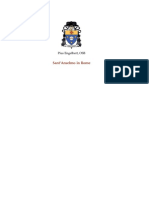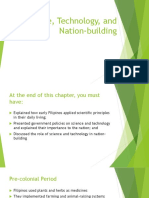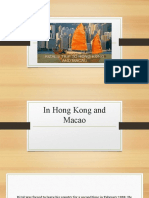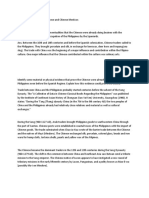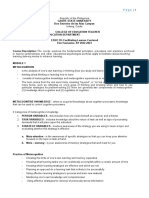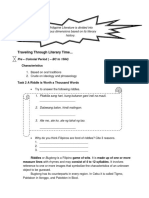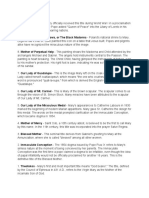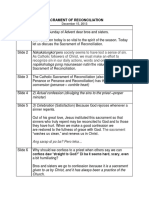Vocabulary Word: Life, Works &writings of Rizal
Vocabulary Word: Life, Works &writings of Rizal
Uploaded by
Ashley jay PalangCopyright:
Available Formats
Vocabulary Word: Life, Works &writings of Rizal
Vocabulary Word: Life, Works &writings of Rizal
Uploaded by
Ashley jay PalangOriginal Title
Copyright
Available Formats
Share this document
Did you find this document useful?
Is this content inappropriate?
Copyright:
Available Formats
Vocabulary Word: Life, Works &writings of Rizal
Vocabulary Word: Life, Works &writings of Rizal
Uploaded by
Ashley jay PalangCopyright:
Available Formats
LIFE, WORKS &WRITINGS OF RIZAL
CHAPTER 7: EMERGING NATIONALISM
VOCABULARY WORD
EPISCOPAL VISITATION – an official visit conducted by the bishop on a diocese t examine the
conditions of a congregation; often done once every three years.
GARROTE – an apparatus used for capital punishment in which an iron collar is tightened around
the condemned person’s neck.
POLO – a system of forced labor that required Filipino males from 16-60 years old to render
service for a period of 40 days.
REGULAR CLERGY –priest who do not belong to religious orders and are engaged in pastoral
work.
SECULAR CLERGY –a system of taxation imposed by the Spanish colonial government on the
Filipinos in order to generate resources for the maintenance of the colony.
CAVITY MUTINY
On January 20, 1872, approximately 250 Filipino soldiers and worker rose in revolt at an arsenal
in Cavite.
An oft-cited reason for the mutiny was a decree released by Governor-General Rafael de
Izquierdo.
The said decree stated that:
Arsenal worker would no longer exempt from the tributo and polo and the privileges they have
enjoyed in the past
Official reports also claimed that the leaders of the mutiny had expected the support of close to
2,000 men from regiments based both in Cavite and in Manila.
SECULARIZATION MOVEMENT
The introduction and the strengthening of the Catholic faith were largely through the efforts of two
types of clergy: the secular and regular priests.
THE REGULAR PRIEST –whose jurisdiction fell on their elected delegates, were better
prepared for missionary work because of their standards of discipline and asceticism. Their
job was to introduce the faith, covert the natives, and establish communities.
In the Philippines, five religious orders took on this task:
The Augustinian, who arrived in 1565
The Discalced Franciscans, who arrived in 1578
The Jesuits, who arrived in 1581
The Dominicans, who arrived in 1587
The Augustinian Recollects, who arrived in 1606
LIFE, WORKS &WRITINGS OF RIZAL
THE SECULAR CLERGY – on the other hand, were priest who “lived in the world”. They were
under the authority of bishops and not a member of a religious order. Their primary task
was the management of religious communities and ideology, and the continuation of the
work already laid down by the regular clergy.
TASK
THE REGULAR CLERGY – introduced the faith and established religious community.
THE SECULAR CLERGY – management of the parishes.
EXECUTION OF GOMEZZ, BURGOS, AND ZAMORA.
As a result of the revolt in Cavite, several priests and laymen were arrested on the orders of
Governor-General Izquierdo.
Among the priests arrested in the succeeding days were Fathers Jose Burgos, Jacinto Zamora,
Mariano Gomez, Jose Guevara, Feliciano Gomez, Mariano Sevilla, Bartolome Serra, Miguel de
Laza, Justo Guazon, Vicente del Rozario, Pedro Dandan, and Anacleto Desiderio.
GOMBURZA
Collective name of the three martyred priests.
Tagged as the masterminds of the Cavite Mutiny.
They were prominent Filipino priests charged with treason and sedition.
The Spanish clergy connected the priests to the mutiny as part of a conspiracy to stifle the
movement of secular priests who desired to have their own parishes instead of being assistants
to the regular friars.
Father Mariano Gomez
An old man in his mid-’70, Chinese-Filipino, born in Cavite.
He held the most senior position of the three as Archbishop’s Vicar in Cavity.
He was truly nationalistic and accepted death penalty calmly as though it were his penance for
being pro-Filipinos.
Father Jose Burgos
Spanish descent, born in the Philippines. He was a parish priest of the Manila Cathedral and had
been known to be close to the liberal Governor-General de la Torre.
He was 35 years old at that time and was active and outspoken in advocating the Filipinization
of the clergy.
Father Jacinto Zamora
37 years old, was also Spanish, born in the Philippines.
He was the parish priest of Marikina and was known to be unfriendly to and would not
countenance any arrogance or authoritative behavior from Spaniards coming from Spain.
You might also like
- Week 5 BDocument10 pagesWeek 5 BVencint LaranNo ratings yet
- Historical Perspectives in - DisabilityDocument17 pagesHistorical Perspectives in - DisabilityKavi RehabianNo ratings yet
- Chapter 7 RizalDocument3 pagesChapter 7 RizalJohnpert ToledoNo ratings yet
- Folk Saints in The Folk Catholicism of The AmericasDocument25 pagesFolk Saints in The Folk Catholicism of The AmericasAngela Natel100% (1)
- Sant'Anselmo in Rome: Pius Engelbert, OSBDocument57 pagesSant'Anselmo in Rome: Pius Engelbert, OSBWorsucheNo ratings yet
- EthicsDocument38 pagesEthicsMariz BuetaNo ratings yet
- Rizal at Ateneo de ManilaDocument21 pagesRizal at Ateneo de ManilaMariel Cuares100% (2)
- PHIL. NATIONALISM MergedDocument61 pagesPHIL. NATIONALISM MergedJohnny King ReyesNo ratings yet
- The Meaning of Organizational LeadershipDocument9 pagesThe Meaning of Organizational LeadershipJirah Joy PeañarNo ratings yet
- Chapter Vi Ethics (Final)Document96 pagesChapter Vi Ethics (Final)KurtNo ratings yet
- 3.science Technology and Nation Building 1Document8 pages3.science Technology and Nation Building 1jefferson pesado100% (1)
- The Kartilya NG Katipunan: Emilio JacintoDocument9 pagesThe Kartilya NG Katipunan: Emilio JacintoMacsNo ratings yet
- GE7 STS Activity 1 1Document4 pagesGE7 STS Activity 1 1Boy P LasolaNo ratings yet
- The Issue On Religion - Proj.Document14 pagesThe Issue On Religion - Proj.GersonCallejaNo ratings yet
- In Sunny (1882-1885) : SpainDocument39 pagesIn Sunny (1882-1885) : Spainken anoberNo ratings yet
- How Does The Katipunan Understand The State and Government and LeadershipDocument1 pageHow Does The Katipunan Understand The State and Government and LeadershipKarl Geelo100% (1)
- Module 10 The Birth of National ConsciousnessDocument19 pagesModule 10 The Birth of National ConsciousnesssvpssvpsNo ratings yet
- GEC09 Module #4 (Bernales, JLE)Document2 pagesGEC09 Module #4 (Bernales, JLE)Jan Lianne BernalesNo ratings yet
- Lec 8 and 9 GeneticsDocument42 pagesLec 8 and 9 GeneticsPEARL BEATRICE GONZALESNo ratings yet
- In Hong Kong and MacaoDocument17 pagesIn Hong Kong and MacaoMadali Ghyrex ElbanbuenaNo ratings yet
- The First Voyage Around The World by MagellanDocument6 pagesThe First Voyage Around The World by MagellanMay Anne EnnaNo ratings yet
- 3rd Republic (1946-1969)Document36 pages3rd Republic (1946-1969)SarTomNo ratings yet
- Modern DanceDocument26 pagesModern DanceGenevee Ryeleen DelfinNo ratings yet
- Lesson 1 Meaning and Relevance of HistoryDocument4 pagesLesson 1 Meaning and Relevance of HistoryJanderick DeveraNo ratings yet
- Readings in The PH HistoryDocument6 pagesReadings in The PH HistoryPatricia Faye T. AsuncionNo ratings yet
- Lesson 7: Revisiting Corazon Aquino's Speech Before The U.S. CongressDocument4 pagesLesson 7: Revisiting Corazon Aquino's Speech Before The U.S. CongressNikka Jane MolobocoNo ratings yet
- Relationship With Josephine BrackenDocument9 pagesRelationship With Josephine BrackenNothingNo ratings yet
- The Indolence of The Filipino by Rizal, José, 1861-1896Document35 pagesThe Indolence of The Filipino by Rizal, José, 1861-1896Gutenberg.orgNo ratings yet
- A Proposal On Writing A Novel About The PhilippinesDocument2 pagesA Proposal On Writing A Novel About The PhilippinesDaniel Lalas Padayhag67% (3)
- Issues in Understanding CultureDocument26 pagesIssues in Understanding CultureShawn Michael Doluntap100% (11)
- NAME: D/C Yuson, Deniel Franz Josef F. DATE: March 10, 2021 Section: MV 1 - 1 SUBJECT: History 101 INSTRUCTOR: Mr. Demberge CaballesDocument1 pageNAME: D/C Yuson, Deniel Franz Josef F. DATE: March 10, 2021 Section: MV 1 - 1 SUBJECT: History 101 INSTRUCTOR: Mr. Demberge CaballesRigel LimaNo ratings yet
- Joexercise 5.2.2 Rizalistas vs. PilarlistaDocument6 pagesJoexercise 5.2.2 Rizalistas vs. PilarlistaEmmanuel PalomaNo ratings yet
- Rizal - PPT 2Document23 pagesRizal - PPT 2Jan Lester TipdasNo ratings yet
- Nature and Origin Theories of Social Studies RevisedDocument3 pagesNature and Origin Theories of Social Studies RevisedJustine Kim BaelNo ratings yet
- Module in PED 112 Chapter 1 5Document27 pagesModule in PED 112 Chapter 1 5Lene OfallaNo ratings yet
- MestizoDocument3 pagesMestizoEva GalletesNo ratings yet
- Ra 9293 PDFDocument28 pagesRa 9293 PDFMariane Joyce MianoNo ratings yet
- Philippines Social EnvironmentDocument9 pagesPhilippines Social EnvironmentJasper CheungNo ratings yet
- Kartilla NG KatipunanDocument3 pagesKartilla NG KatipunanRoshin TejeroNo ratings yet
- Instructions: Read One of The Three Articles and Accomplish The Metacognitive Reading ReportDocument2 pagesInstructions: Read One of The Three Articles and Accomplish The Metacognitive Reading ReportJudence LopezNo ratings yet
- FT Notes 2 - Task No. 1 - Tenor, The Corporate World and SWOT Analysis (Week 11)Document9 pagesFT Notes 2 - Task No. 1 - Tenor, The Corporate World and SWOT Analysis (Week 11)Johane Grei WallNo ratings yet
- EDUC 70 Module 1Document6 pagesEDUC 70 Module 1Leslie mae GioNo ratings yet
- Amor PatrioDocument5 pagesAmor PatrioMary Grace Salvador BonggoNo ratings yet
- 10 Teaching of Kartilya NG KabataanDocument13 pages10 Teaching of Kartilya NG KabataanJewelle Vincent Dags AtienzaNo ratings yet
- Siblings of Dr. Jose RizalDocument5 pagesSiblings of Dr. Jose RizalCha MirandaNo ratings yet
- The Political System Under Spanish ColonialismDocument16 pagesThe Political System Under Spanish ColonialismJoe Oliveros ChannelNo ratings yet
- Jose Rizal MidtermDocument11 pagesJose Rizal MidtermJosiah VinoNo ratings yet
- Module 5 Learning Activity 1Document20 pagesModule 5 Learning Activity 1Angela Beatrice100% (1)
- Module 3 - Pre Spanish PeriodDocument3 pagesModule 3 - Pre Spanish PeriodsofiaNo ratings yet
- Lesson 4 - Rizal's Life As A StudentDocument11 pagesLesson 4 - Rizal's Life As A StudentCrl MiNo ratings yet
- Ancestors Life and The Way of Living ReportDocument26 pagesAncestors Life and The Way of Living ReportAndrealyn Gevero IsiderioNo ratings yet
- Prof Ed 4 NotesDocument5 pagesProf Ed 4 NotesGlaiza AlcantaraNo ratings yet
- Pre Coloniial Notes PDFDocument18 pagesPre Coloniial Notes PDFAngeline Limbaga TrayfalgarNo ratings yet
- History Through Paintings and Films SummaryDocument7 pagesHistory Through Paintings and Films Summarygiomascardo53100% (1)
- Activity 3 RizalDocument21 pagesActivity 3 Rizalellesor macalamNo ratings yet
- LT2 149Document4 pagesLT2 149Michael Brian TorresNo ratings yet
- Dagami RevoltDocument4 pagesDagami RevoltRichardDinongPascualNo ratings yet
- RizalDocument23 pagesRizaljanit oberezNo ratings yet
- Module 1 Movements Education 2Document24 pagesModule 1 Movements Education 2Mariel CondesaNo ratings yet
- Jose P. Laurel Educational Background and PhilosophyDocument11 pagesJose P. Laurel Educational Background and PhilosophycyrelljanenasisNo ratings yet
- The Case for Masks: Science-Based Advice for Living During the Coronavirus PandemicFrom EverandThe Case for Masks: Science-Based Advice for Living During the Coronavirus PandemicNo ratings yet
- 3.3 Emerging Nationalism - SOCSC 005-ARCH42S6 - Life and Works of RizalDocument7 pages3.3 Emerging Nationalism - SOCSC 005-ARCH42S6 - Life and Works of RizalAngelo OñedoNo ratings yet
- Vocabulary: Life, Works & Writings of RizalDocument3 pagesVocabulary: Life, Works & Writings of RizalAshley jay PalangNo ratings yet
- Vocabulary Words: Life, Works & Writings of RizalDocument2 pagesVocabulary Words: Life, Works & Writings of RizalAshley jay Palang100% (1)
- BSMT 2-B - Palang, Ashley Jay E. - ACTIVITY 1 - RIZAL AND GOMBURZADocument2 pagesBSMT 2-B - Palang, Ashley Jay E. - ACTIVITY 1 - RIZAL AND GOMBURZAAshley jay Palang100% (2)
- BSMT II-B Palang, Ashley Jay E. - CHAPTER 5 - SUMMATIVE ACTIVITYDocument2 pagesBSMT II-B Palang, Ashley Jay E. - CHAPTER 5 - SUMMATIVE ACTIVITYAshley jay Palang88% (8)
- Noli Me Tangere - IntroductionDocument3 pagesNoli Me Tangere - IntroductionCHERYL TENCHAVEZ DEANONo ratings yet
- Noli Me Tángere Chapter 49-WPS OfficeDocument5 pagesNoli Me Tángere Chapter 49-WPS OfficeLove clipseNo ratings yet
- History of MedalDocument2 pagesHistory of Medalbryan cagang gomezNo ratings yet
- Local Media7004600918096391891Document2 pagesLocal Media7004600918096391891Niemar AbaloNo ratings yet
- 1521 Easter Sunday Mass: First Recorded Mass in The PhilippinesDocument9 pages1521 Easter Sunday Mass: First Recorded Mass in The PhilippinesIsa BellaNo ratings yet
- Father Schaller LetterDocument2 pagesFather Schaller Letterapi-304304950No ratings yet
- The Church'S Social Mission Why Does The Church Have A Social Doctrine?Document6 pagesThe Church'S Social Mission Why Does The Church Have A Social Doctrine?Jay VillasotoNo ratings yet
- Schumacher DocumentsRelatingFather 1969Document74 pagesSchumacher DocumentsRelatingFather 1969José Bolima RemillanNo ratings yet
- Les MisérablesDocument439 pagesLes Misérablessawlinjahan88No ratings yet
- Day 1, Novena For Our Nation - Perfection - Dare To Live in Him PDFDocument4 pagesDay 1, Novena For Our Nation - Perfection - Dare To Live in Him PDFlocklobsterNo ratings yet
- MARYDocument2 pagesMARYAJNo ratings yet
- Rel 211 Course Outline-1Document3 pagesRel 211 Course Outline-1eduuNo ratings yet
- RPH Research Jasmin MDocument11 pagesRPH Research Jasmin MJasmin MaravillaNo ratings yet
- Brother Marcel VanDocument13 pagesBrother Marcel VanSolidarity of All SaintsNo ratings yet
- The InquisitionDocument3 pagesThe Inquisitionapi-278839315No ratings yet
- Caterisirea Lui Ciprian de Oropos - 1986 PDFDocument11 pagesCaterisirea Lui Ciprian de Oropos - 1986 PDFVio VioletNo ratings yet
- Book 1Document61 pagesBook 1Jose Rhey OsabalNo ratings yet
- 5 Min CCC 03 - Confession EngDocument2 pages5 Min CCC 03 - Confession EngDik SajonaNo ratings yet
- Saint Jérôme About Heretic PeopleDocument5 pagesSaint Jérôme About Heretic PeopleDAVID GAINACK SENENo ratings yet
- Bag-Ong Lamdag September Issue 2020Document8 pagesBag-Ong Lamdag September Issue 2020Tesay EspinaNo ratings yet
- Chapter 3Document1 pageChapter 3Louis Lhynferd ReyesNo ratings yet
- Caritas in VeritateDocument36 pagesCaritas in VeritateKarlo OfracioNo ratings yet
- Canon_regular of Saint AugustineDocument18 pagesCanon_regular of Saint AugustineagobardojohnsonNo ratings yet
- Dagyaw 2022 Excuse LetterDocument5 pagesDagyaw 2022 Excuse LetterKeith Cyron VillanuevaNo ratings yet
- Hunting The Whore of Babylon - Catholic AnswersDocument4 pagesHunting The Whore of Babylon - Catholic AnswersdjhlllNo ratings yet
- Canterbury CathedralDocument28 pagesCanterbury CathedralPablo SakakiNo ratings yet
- Rev. Fr. Felix Legaspi Iii Op Vocation Promoter Dominican Province of The Philippines Sto. Domingo Convent 537, Quezon Avenue, 1114, Quezon CityDocument1 pageRev. Fr. Felix Legaspi Iii Op Vocation Promoter Dominican Province of The Philippines Sto. Domingo Convent 537, Quezon Avenue, 1114, Quezon CityVirtus Kenoi67% (3)
- OrdinationsDocument3 pagesOrdinationscebracamonteNo ratings yet




